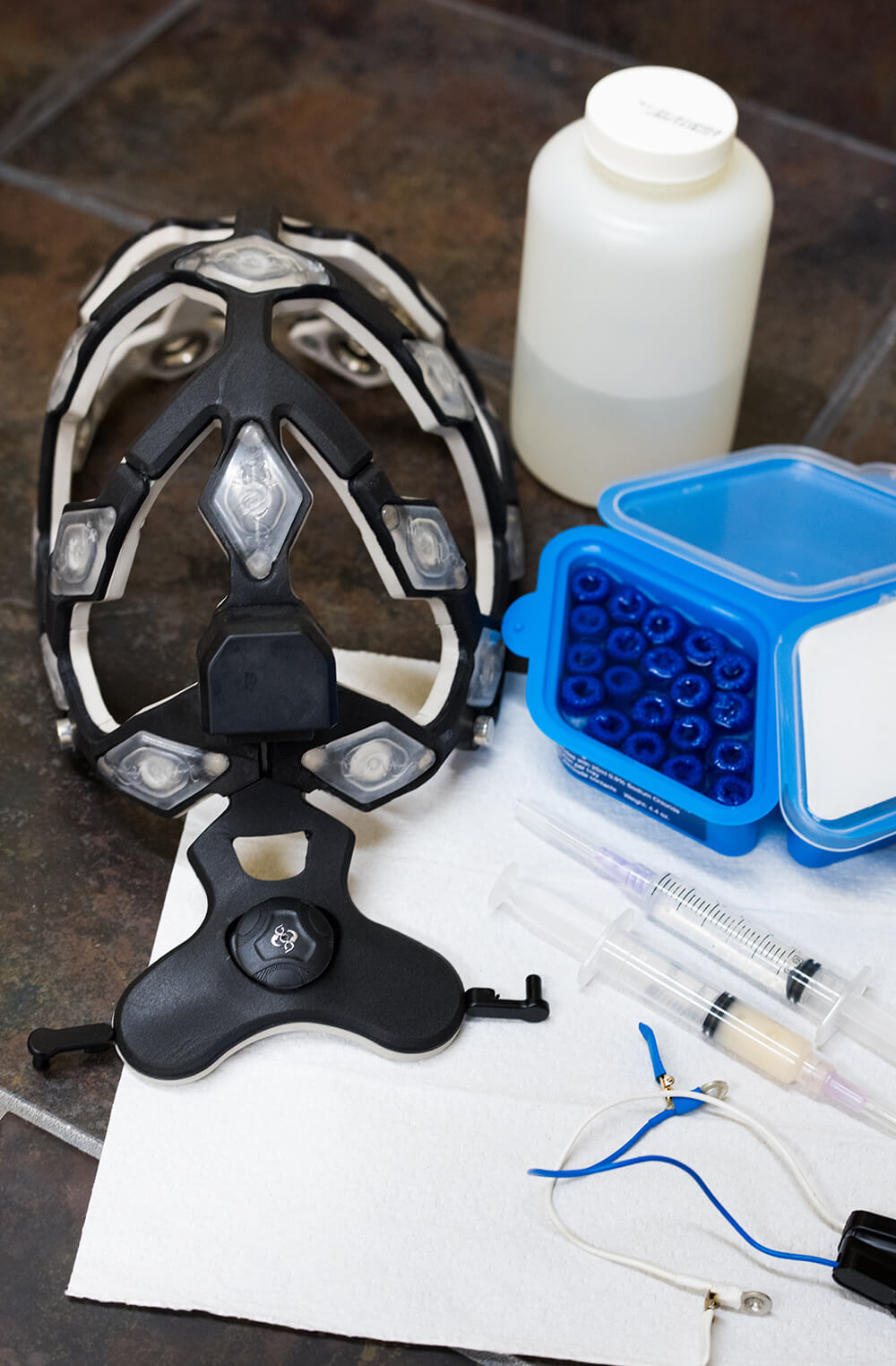
Some of the equipment used in the testing.
When I was opening the door to the clinic, the nagging worry I’d been having since I’d agreed to this appointment morphed into a quasi-panic attack. I was at the Sebring Clinic in Wimberley, Texas, outside Austin, to get my brain health checked. That was the general premise. What I specifically wanted to know is if I had early signs of dementia. I mean, at 56, I’ve had too many moments when my mental wheels are spinning desperately looking for something innocuous like the name of the restaurant where we ate at two days ago but the rubber never hits the road. Who hasn’t, right? Right?!?
A few weeks earlier, I had met Nicole Knicely, a trainer for Seeking Perfect Health, the distributor for a new technology that measures the brain’s quality (speed), voltage (power), reaction time, attention, and speed of processing. It is similar to, but less detailed than, an EEG, which is a very expensive diagnosis tool that can only be used if a doctor determines there’s an urgent medical reason (in other words, covered by insurance).
At 56, I’ve had too many moments when my mental wheels spin but the rubber never hits the road.
The clinic in Wimberley is one of five locations in the country where the technology, called WAVI, is available after being field tested nationally for the past five years. Seeking Perfect Health has developed a brain wellness program and plans to get it and the WAVI technology into doctors’ offices and clinics across the country so that brain health screening will be accessible and affordable—less than $200.
“A New Paradigm”
“The technology is a new paradigm in medicine. It’s the first time people can get affordable, objective testing of their brain health,” said Mike Clark, the president of Seeking Perfect Health, who has a PhD in natural medicine. “We get our blood pressure and cholesterol checked. Why wouldn’t we get our brain health checked?”
“We get our blood pressure and cholesterol checked. Why wouldn’t we get our brain health checked?”
Uh…because we’re scared. Scared of ending up like my dear Uncle Jim, who is alone and out of it in an Alzheimer’s unit, so gaunt that I barely recognize him anymore and, of course, he doesn’t recognize me. I mean, if that’s our fate, isn’t ignorance bliss?
When I told Clark my fears, he assured me that there are preventive measures people can take if they catch the signs early enough. He’s not talking about drugs, but as a decades-long practitioner of natural healing, he means through diet, supplements and lifestyle, which I appreciate.
Why Knowledge is Power
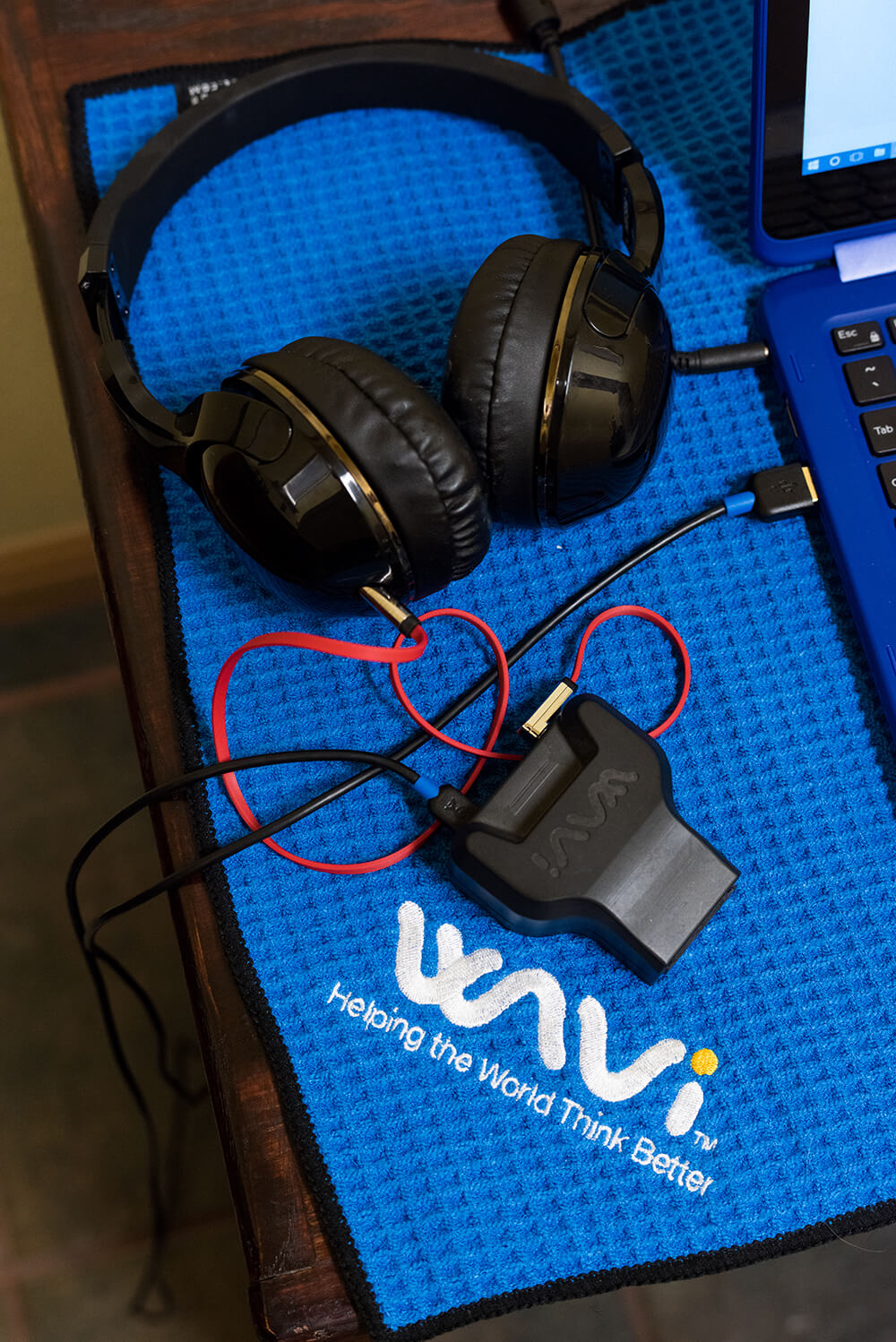
The WAVI system now makes brain screening affordable and accessible.
After testing and an interview with a patient to better interpret the raw data, Clark and Seeking Perfect Health will recommend a brain health plan that usually includes–among other suggestions for those who have noticeable deterioration–more physical activity (at least 30 minutes a day) and a diet (such as Paleo) that provides the fat the brain requires and daily doses of fish oil rich in Omega 3 as well as vitamin D3. When I asked Clark if he had any case studies of dementia improvement, he says there hasn’t been enough time to do so; the WAVI system was released into the market in January.
However, he points out that research has shown that the brain can regenerate itself even into our 90s, something called neurogenesis, and that Alzheimer’s isn’t as hopeless as I thought—all the reports I’ve read indicate there’s virtually nothing to be done to stop its brutal march.
Research has shown that the brain can regenerate itself even into our 90s, something called neurogenesis.
He cited a recent Cambridge University study estimates that about one-third of the 44 million people with Alzheimer’s could have prevented the disease by making different lifestyle choices. According to the study, the disease is consistently linked with seven main risk factors: diabetes, midlife hypertension, midlife obesity, physical inactivity, depression, smoking, and low educational attainment.
Better to Know Now?
Other scientific findings that support his methods: This May’s Journal of Alzheimer’s Disease reported that high omega-3 intakes increase blood flow to the brain, suggesting a link between omega-3 and Alzheimer’s disease. Several studies have shown that physical activity likely reduces the risk of Alzheimer’s. The Mayo Clinic recommends exercising for 30 to 60 minutes several times a week to increase blood flow to the brain and also to boost certain chemicals that protect the brain.
“The idea is to catch it early enough and then prevention, prevention, prevention.”
“Would you want to wait till you had a heart attack to find out that you had a cardiovascular problem?” Clark asked. “The idea is to catch it early enough and then prevention, prevention, prevention.”
OK, OK. I got it. I told myself that if a problem were found, I’d become more of an exercise junkie than I already am and start popping Omega-3s like jelly beans. I decided to bring my husband Robb along for testing too. If I flunked the test, he should know, I figure. And I realized that if he had a problem, I’d be dealing with that down the road, so better to know now. Plus, my husband and I are very competitive, which I’ve written about before, and I was eager to see how our brains stacked up against each other. Silly me.
Mapping My Midlife Brain
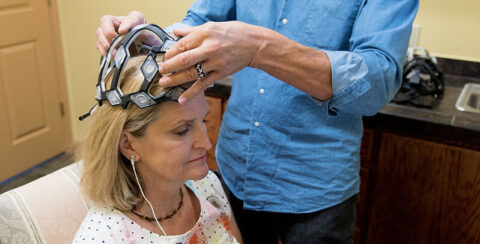
Jeannie gets the helmet fitted on her head.
At the clinic on testing morning, Nicole Knicely led us into a small room where I saw three sizes of a helmet that looks like some futuristic turtle shell. The helmet, which is FDA approved, has 20 nodes that record activity in different parts of your brain.
My husband put on the helmet first and went through 20 minutes of testing. He seemed to do fine but we didn’t have any way of knowing for sure at that point, which heightened the tension for me. Then it was my turn. After Nicole made sure that all the nodes, which made contact all over my cranium, temples, and earlobes, were conducting electricity properly, my test began.
The helmet, which is FDA approved, has 22 nodes that record activity in different parts of your brain.
The first test was called a P300 delay; electrodes measure the time between a stimulus and your brain’s response. For this test, I sat with my eyes closed and clicked a mouse whenever I heard a beeping noise. On the screen in front of me (of course I peeked) were undulating lines indicating brain-wave readings from each node. The second test involved staring at the wall with my eyes open, doing nothing, but nonetheless the lines were still flowing across the screen.
Then I was asked to perform two activities, called trail-making tests. The first test displayed 25 dots randomly on the screen, each one numbered. I was timed on how quickly I could touch the dots on the screen in consecutive order, which was straightforward and fairly easy. The second test showed 25 dots, 13 numbered and 12 with letters A through L. My task was to touch 1 then A, 2 then B, 3 then C and so forth, while being timed. For some reason, I found this activity easier than the first, maybe because I’m such a verbal person and feel more comfortable with letters than numerals.
Getting Graded
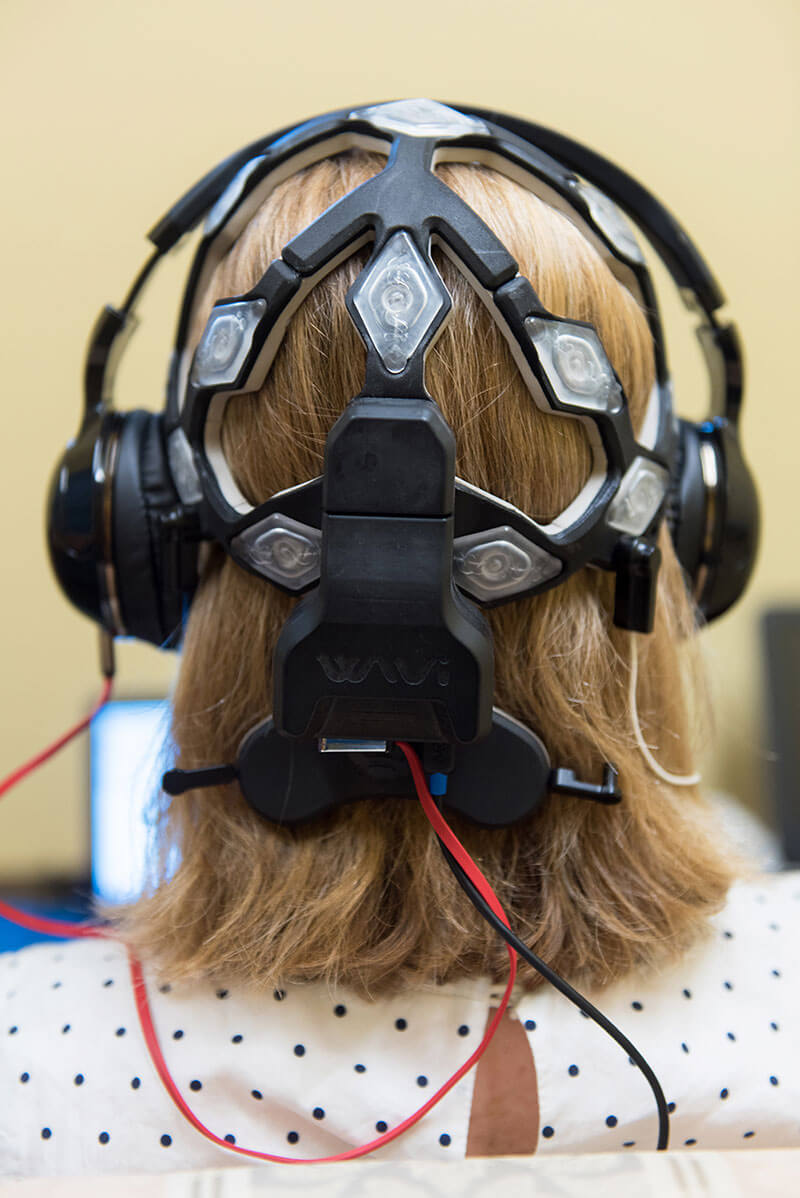
All fired up and ready to go.
So now the moment of truth came: Our results. I wanted Nicole to just tell me “Yes” or “No” on the dementia thing. I was feeling a bit queasy and my head was hurting, which I didn’t think was a good sign. However, Nicole was methodical. She gave us a printout of our scores plus the range of scores that were deemed appropriate for our age. My eyes scanned up and down all the columns of numbers but it was hard to take everything in. There was no heading that said, “Look Here for Dementia Risk.”
On the P300 Delay test, Robb and I scored exactly the same: 308 milliseconds. (The normal range for our age is 293 to 341 ms.) On physical reaction time, it took me 362 milliseconds to click the mouse, while it took Robb only 263. (Normal range is 346 to 416 milliseconds.) I wasn’t too happy about getting beat out by my husband, but at least I was well within normal.
The next set of figures were the most upsetting of the day.
The next set of figures were the most upsetting of the day. The electrodes measure brain voltage throughout the testing and map which areas of the brain are firing most. These results can be used to detect asymmetry or possible brain injuries. Robb’s voltage measured 17 watts, with 9 to 19 being normal at our age. A color scan of his brain, showed a stripe of red from his frontal lobe to the center of his brain (red being the highest voltage). My results: 9 watts and a mélange of yellow, blue, and a tiny bit of red.
Uh oh! Power Problems
“Look at that, look at that,” Robb crowed. “My brain is on fire. Yours, uh…not so much.”
Nicole, not knowing our competitive, trash-talking natures, seemed a bit shocked. She went on to ask me about any head injuries, and I told her about a fluke fall while waterskiing two weeks earlier. I had ended up with a massive headache that made me nauseous; the nausea went away after a day but my head hurt for the next five days.
Now the question I dreaded: “Is this a sign of dementia?”
“You could have had a concussion for sure,” Nicole said, though I found it hard to believe that falling on water could cause a concussion. She emphasized that low voltage is one of the main consequences of a concussion. Seeking Perfect Health hopes to use the brain screening on athletes (especially young athletes). “This takes the guess work out of concussion protocols,” she said. “We recommend all athletes get a baseline scan so we can determine if a brain injury has occurred and if it has healed.”
Nicole explained that low voltage can also be brought on by serious stress. I told her that, yes, my stress had been considerable over the past few months as I worked on a start-up business. She suggested a retest a couple of months later to see if my brain had repaired itself and recommended 5,000 milligrams of Omega-3 per day (which I immediately started taking).
Now the question I dreaded: “Is low voltage a sign of dementia?”
Nicole smiled and shook her head. “Don’t worry. This is where we see problems with dementia.” She pointed to results for the trail-making tests.
Where Possible Dementia Shows Up
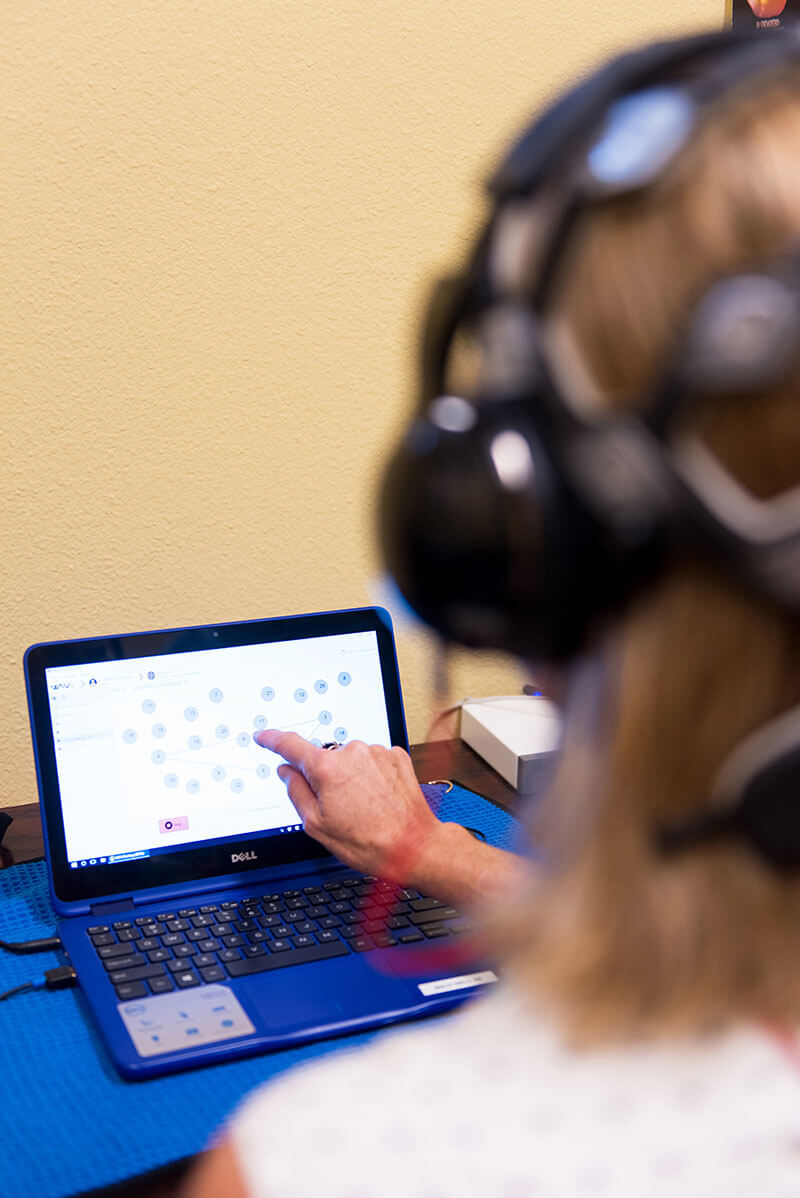
Jeannie taking the trail making test.
On the first test (connecting the dots in numeric order), it took me 47 seconds and Robb 31. Normal range is 35-51 seconds. On the second test (connecting numbers with letters in numeric-alphabetic pairs), I’m proud to report I blew the doors off. It took me 53 seconds and Robb 78. (Smoked him!) Normal range is 64 to 108 seconds.
“On the more complex test, you were more efficient,” said Nicole. “It suggests you’re good at multi-tasking.” Yes, I thought, recalling all the times I’d folded laundry while nursing a baby and reading a magazine. Just a few days earlier, I had been on a conference call as I (quietly) cut vegetables for dinner. Yes, I am good at multi-tasking. What woman isn’t?
The trail-making tests are key to signaling a risk for dementia and Alzheimer’s. “People with dementia have a really hard time with these tests,” Clark told me later. And those showing early signs of trouble might have scores above normal range. (Slow processing times—the first test—may also be an indication.) It was as if the cloud that had wrapped itself around my head since we’d decided to get tested had evaporated. So far so good. Clark also pointed out it is helpful to have a baseline score on these tests so that any future issues can be quickly detected.
Clark pointed out it is helpful to have a baseline score on these tests so that any future issues can be quickly detected.
Other findings showed that Robb and I were in the normal range on scores for tests that can reveal depression and ADHD (attention deficit hyperactivity disorder)—brain scans to reveal ADHD have been FDA approved since 2013. Clark reports that in their field testing on the WAVI technology, they have come across a number of ADHD adults who were never diagnosed.
He’s also tested teens and young adults who have been told they have ADHD but brain screenings show they don’t. “Current subjective methods of determining a diagnosis of ADD/ADHD often lead to incorrect diagnosis,” says Clark. “This is an objective test; this is front line information that’s not been available before.” Indeed, the testing done with my eyes open is considered the gold standard for ADHD screening, Nicole told me.
The T-Shirt Wars Are On
Another reason I’m not happy is that now I’ve handed my husband a way to pluck my string. When we got home, Robb showed me an illustration on his computer, a vintage logo used on every Eveready battery, including, yes, its 9-volt one. The logo is a cat jumping through the loop of the number 9.
“I wonder,” he said with a snicker, “if I can find this on a T-shirt for you.”
“Sure,” I said, doing a search for an image on my computer: A bare butt. “As long as I can get you a shirt with this on it.” OK, my brain may be low-voltage, but I was relieved it had enough spark to dish it right back.
Photos by Rebecca L. Bennett
Here are some recommended books on brain health and Alzheimer’s prevention.

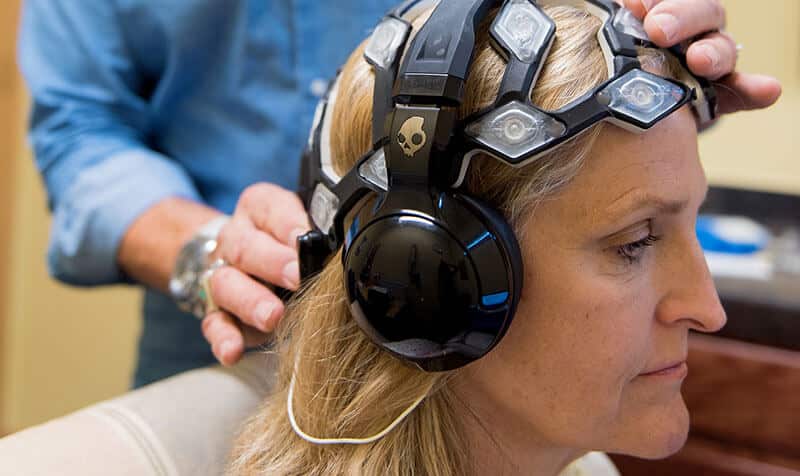


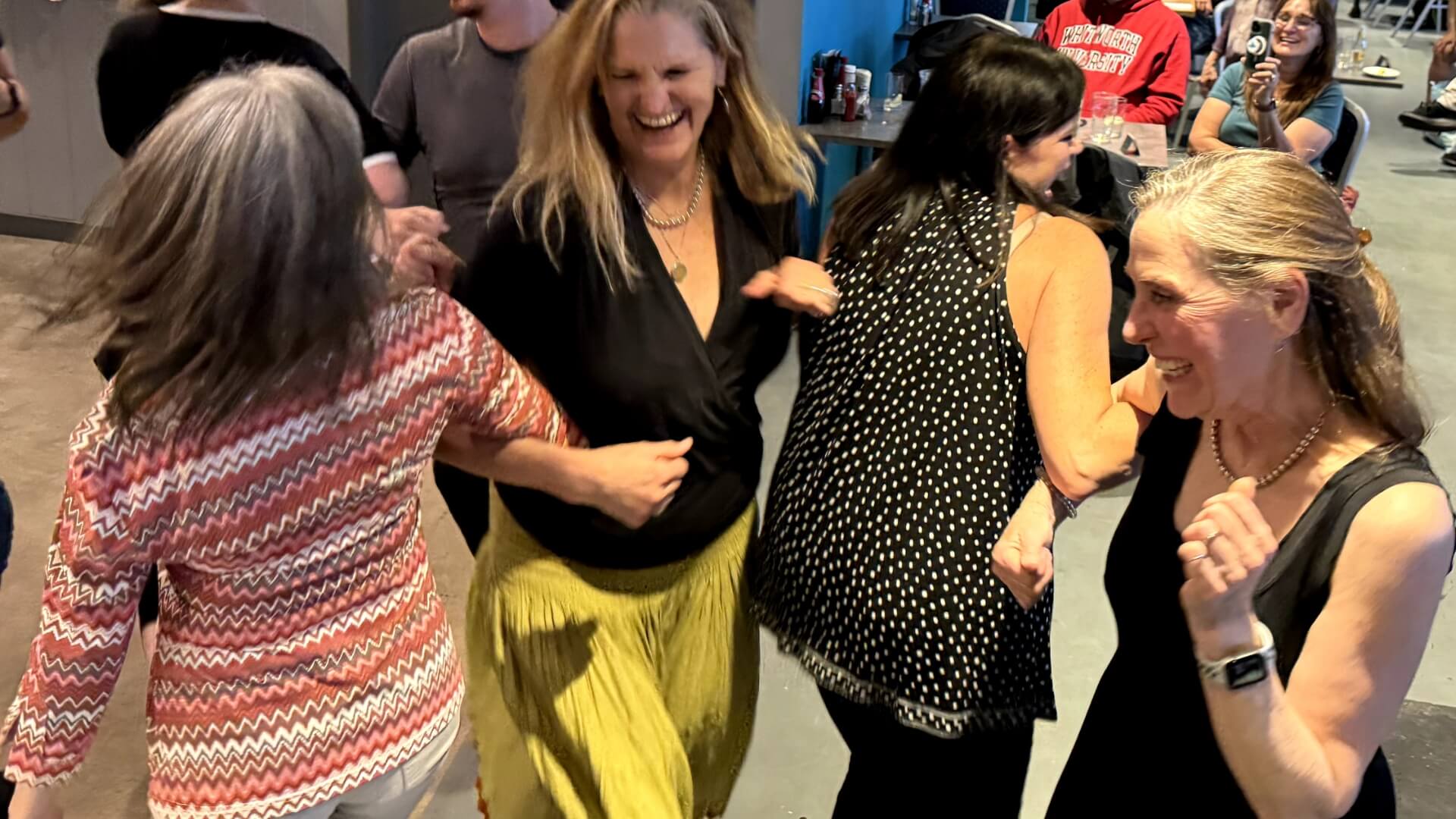














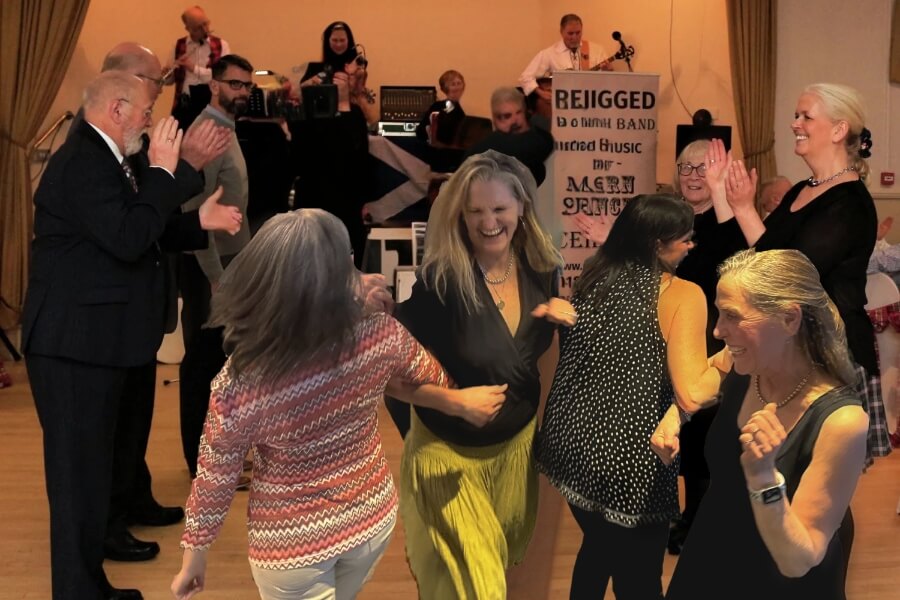

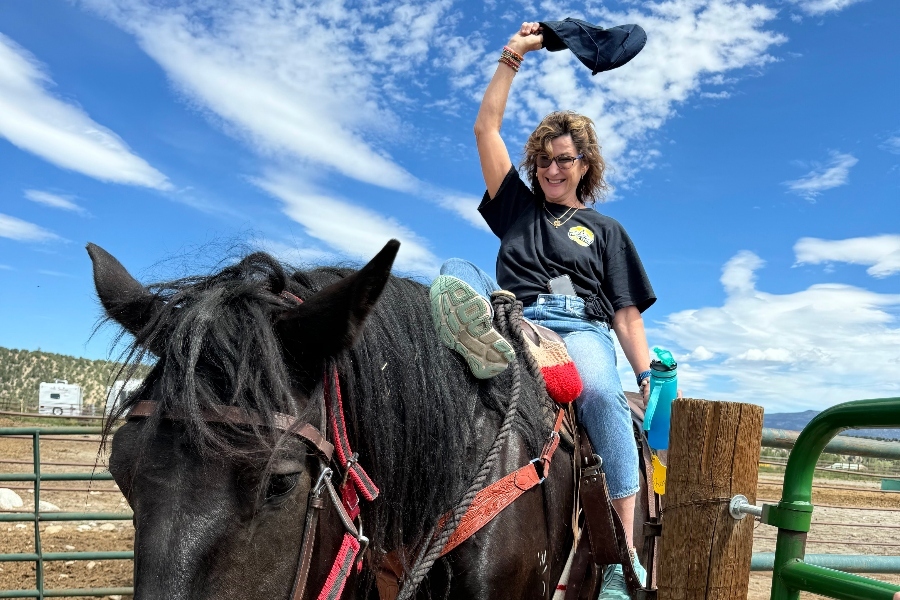


0 Comments